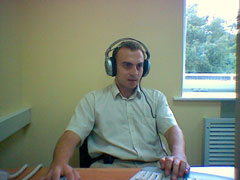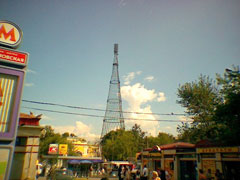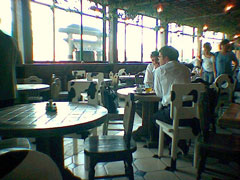HTC Blue Angel by the example of GSM-communicator – Qtek 9090
Standard kit:
- Phone
- Combined USB-COM cable for synchronization
- Cradle
- Case
- Charger
- Headset
- CD with software
- Documentation
Live pictures
The elite flight squadron in the USA is called Blue Angels. Its
main aim is to make performances in the air flying on Boeing F/A-18
and support recruiting. Marlene Dietrich became famous all over
the world due to the film - “The Blue Angel” produced in 1930, a
successful remake of this popular film was shot in 1959. The film
and performances has no connection between each other. Blue Angel
is also a name of one of the monitor safety standards (similar to
TCO'95). It turned out that the word-combination “Blue Angel”
is also connected with smartphones. The Taiwanese company High Tech
Computers (HTC) chose this codename for the Pocket PC smartphones
of the third generation (a codename of CDMA version is HTC Harrier).
We can only guess whether managers of this company watched the film
or/and American performances in the air or not.

HTC Blue Angel hardaware platform will appear soon on the market
in different devices (Qtek 9090, MDA III, O2 XDA III and others).
All of them will not have any differences in design and filling,
just small cosmetic differences in software will take place (own
screen saver of the operator, for example). Thus, all conclusions
about Qtek 9090 will remain the same regarding other devices based
on HTC Blue Angel.
HTC Blue Angel has considerable differences from the predecessors of these
smartphones (HTC Himalayas, or Qtek 2020, O2 XDA II, MDA II). Here
are the short list of the main differences: a built-in Wi-Fi adapter
(IEEE 802.11b) and “soft” roaming between wireless networks was
added, bluetooth functionality was improved, built-in QWERTY keypad
appeared, ergonomics of the device was improved, the battery capacity
was enlarged, Windows Mobile 2003 Second Edition was installed.
The camera, processor, GSM/GPRS chip and the screen almost were
not changed. They will be improved only in the smartphones of the
fourth generation from HTC. Now let us turn to the review.
The design of the Blue Angel in the closed mode (when the keypad
is hidden) is almost the same as the previous smartphone had. One
can see a classic bar type design typical for Pocket PC, its edges
are smooth and symmetric. The new smartphone is a little bit thinner,
wider and smaller than its predecessor, but you can notice it only
when lay two devices near each other and compare them.
- HTC Himalayas : 130x69.9x19 mm 185 g
- HTC Blue Angel: 125x71.6x18.7 mm 212 g
- SonyEricsson P910: 115x58x26 mm 155 g
- HP iPaq 4150: 113.6õ70.6õ13.5 mm 133 g

The smartphone is larger than usual business phones and Symbian
smartphones. This device still attracts attention of the people
when you try to speak. Any headset (wire or wireless) can solve
this problem. We tested the smartphones with a Bluetooth headset
– Jabra BT 250. By the way, the talk with a help of wireless headset
attracted even more attention than without it.
The device lies well in the hand due to the smooth shape. Black rough plastic of the back cover does not allow the device to slide in the hand. Silver plastic of the front panel is very pleasant, it reminds the metallic surface. Assembly quality is very high, there is no backlash and creaks even if you strongly press the device.

Two soft keys (Calendar and Contacts) are located on the front
part of the PDA above the screen, two LED are responsible for reminders,
GSM-network activity, wireless adapters activity. There are four
new keys under the screen. They are very small and thin because
designers tried to spare the place. Two middle keys call browser
and e-mail client, left and right keys call the menu “Start” and
responsible for “OK” pressure. All these keys improved the ergonomics
of the device. It is possible to assign any key to any action or
application, for example one of them can be assigned to switch on
screen mode (landscape and portrait). The joystick also was improved.
It became larger, the action key is deepened into the case and can
not be pressed by chance. The joystick is not soft as in the previous
smartphone. You press mostly on the rim of the joystick due to it
prominent edges. At last the device is suitable for arcade games
due to new keys under the screen and improved ergonomics of the
joystick. There is a send and reject key near the joystick, they
have a backlighting.

IrDA, camera key and voice record key are located on the left side
of the smartphone. There is a slider to control volume of the phone
(ring or loudspeaker) between the keys. It is not possible to assign
the other actions to it (to scroll electronic books, for example)
using standard settings. Due to efforts of Russian enthusiasts (Des
and mamaich) these possibilities became possible
(here
you can read more about it). By the way, this program is workable
on all Pocket PC devices, where the volume is controlled by side
keys (including HP iPaq 5450). There are no control elements on
the right side of the smartphone.

The stylus, power key, SD/MMC slot with SDIO support (a possibility
to switch on peripheral equipment, not only memory cards), headset
connector (2.5 mm) (included in the standard kit). The quality of
mp3-files is rather high, it is comparable with other Pocket PCs.
The user can connect his/her own earphones using a special adapter
(3.5 mm to 2.5 mm). During the last time prices for SD memory cards
fell down (1Gb SD card costs less than $200), that is why absence
of CF slot in the smartphone has not been a shortcoming yet.
Reset key, cradle and cable connector is placed on the low part
of the device. The connector is differed from the old device, it
means that old cables and cradles can not be used with the new smartphone.
The case and the QWERTY-keypad
One of the main peculiarities of this smartphone is a built-in keypad. When
the lower part of the case is moved down, you can see a QWERTY-keypad.
The slider is opened manually; auto mechanism is absent. You can
open the smartphone rather easily. The parts are tightly pressed
to each other and fixed with a click in both modes. The construction
is very reliable. It is important that you can open the keypad and
dial the number with one hand, it is not so difficult as it seems
at the first sight.

The length of the case is increased up to 170 mm. The weight is concentrated
in the lower part (the battery is above the keypad), that is why
it is very comfortable to hold Blue Angel in the opened mode. The
upper part does not outweigh the lower part as in Sony Ericsson
P910, for instance. It is more comfortable to hold the device with
two hands, typing the text by two thumbs. The keypad is too small
to input text by 10 fingers, and besides it should be used on move.
Small keys are drawn on the surface, it is necessary to press on
the middle of the keys, where there are small prominent parts –
2 mm in diameter.
There are two signs on each key – black and red. To input the red
character it is necessary to press the necessary key and Fn
key. The keypad functionality of Blue Angel is higher if compare
it with the devices based on Palm OS. The keypad allows making different
operations on the smartphone without using stylus (to close application,
to call the menu, to move to another field). Palm OS has very limited
functional possibilities of the keypad.

As for me, OWERTY-keypad is not a great advantage. I can type on
the virtual keypad even faster than on any thumb keypad. But it
is a considerable selling point for many users, especially beginners
(many of those who got acquainted with Qtek 9090 were impressed
by it). The convenience of the keypad we can estimate as the following:
better than on Sony Ericsson P910 and Palm OS based PDA and smartphones,
comparable with Sharp Zaurus C750.

The keypad has a pleasant blue backlighting. All characters are visible in
the darkness, even the rim of the keypad is shined. It is possible
to adjust the backlighting in the settings (time of the backlighting).
If you want you can just switch it off.
Taking into account that all official devices will be with own keyboard layouts,
there is no sense to buy “grey” smartphones, for example produced
by the German operator – T-Mobile. Official shipments of Qtek 9090
on the Russian market will have the Russian keypad.
Camera
Blue Angel has the same VGA-camera as its predecessor. It loses to the devices
with 1-megapixel cameras and even VGA-cameras. The camera lens is
located on the back cover of the smartphone, it is not covered by
the shutter, the protective glass can be easily dirtied up by the
finger-prints. There is a mirror to take the pictures of yourself
under the camera lens. The quality of the pictures is rather low;
you can estimate it looking at the pictures below.
The following resolutions of the pictures are available:640õ480
pixels, 320õ240
pixels, 160õ120
pixels. It is possible to use 2x digital zoom, keep the photos
using both the internal memory of the device and the memory card.
Video clip (with volume) has a resolution of 320x240 pixels, the
only one available resolution in MPEG4 format. The duration of the
video clip is limited by the free memory of the smartphone or memory
card size (SD or MMC). Examples of the video clips are the following:
Examples
of the video clips (mp4, 101 Kb)
Examples
of the video clips (mp4, 90 Kb)
It is possible to adjust manually such things as sharpness, gamma, contrast,
and saturation. There are also several pre-installed ambiences.
By the way, it is necessary to mention the following: the camera
application starts during 1-2 seconds, photos are recorded quickly
in the internal memory of the device, you should not wait for a
long time to take the new picture. The screen is used as a viewfinder
while shooting. The picture is displayed without delays on it.
Battery
Li-Ion battery of 1490 mAh capacity (instead of 1200 mAh capacity
which had the predecessor) is installed in the smartphone. The declared
battery life of the new smartphone is by 25% longer than HTC Himalayas,
it is about 160 hours in the standby mode (7 days) and 4.5 hours
in the talk mode.

In reality the battery life of the smartphone in the standby mode is not longer
than 4 days. In case of active usage (6-9 hours of work) (mp3, Internet
over GPRS, Wi-Fi (1 hour), 20 minutes of talking) the device worked
about 1 day and about 20-30% of battery charge remained. You will
not be able to use Qtek 9090 actively during 2 days. If you use
PDA functions about 3-4 hours per day, then you have a chance to
charge the battery every 2 days. The battery life of Blue Angel
is comparable with other smartphones, may be a little bit longer
due to larger battery capacity.
Display
The display is typical for Pocket PC, it has the resolution of
320*240 pixels (diagonal is 3.5 inch) and is capable to support
up to 65 000 colors. All parameters are rather standard. The information
is quite visible in a sunny day; the picture does not disappear
even under direct sunlight, though it fades a little. There are
11 levels of backlighting.
Unfortunately, the display has the same shortcomings as the screen
of HP iPaq 1940/4150 (HTC is the manufacturer in this case too).
If you look at the display from the bottom, white color will turn
into yellow one. If you look from the top or at right angles, this
problem is absent. In reality this small shortcoming, rather a psychological
one, doesn’t influence the work, because usually we look at the
right angles on the PDA. Look at the photos below.



Memory and productivity
The processor - Intel XScale PXA263, 400 MHz, lies in the heart
of the smartphone. It is possible to increase the speed of the processor
if you want. There is no sense to put a new processor - Intel XScale
PXA270 in the smartphone/PDA with a QVGA-screen (its potential will
not be used). The presence of the old processor - PXA263 is understandable
in Blue Angel. The smartphone has 128 RAM, 125.77 Mb is available
for the user. Large memory capacity has not only advantages, but
also two considerable disadvantages: firstly, it decreases the battery
life in the standby mode, secondly it increases the size of the
backup file. Real available flash memory is 43.26 Mb. Taking into
account that the size of the flash-cards is increasing and the prices
are falling down, the flash memory capacity is not very important
now. It will be necessary if you have too many SD cards and change
them very often. Let’s turn the tests results.
As usual we used the test package - SPB
Benchmark to test the productivity of the device. We used a
PDA with two wireless adapters to compare.

The index describes the productivity of the central processor.
Identical processors show the same productivity, the difference
can be explained by precision of measurements.

This index describes the file system (reading, recording, moving).
Blue Angel (Qtek 9090) shows not bad results.
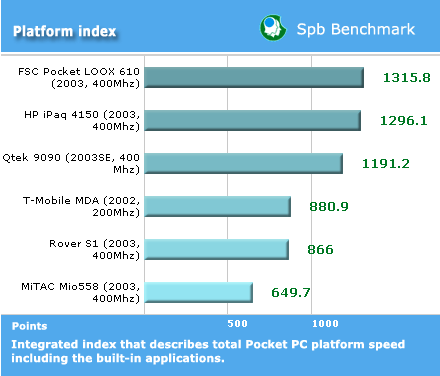
This index describes the built-in applications speed. Results of
this test are similar to the previous one, because the application
speed depends on file system speed.
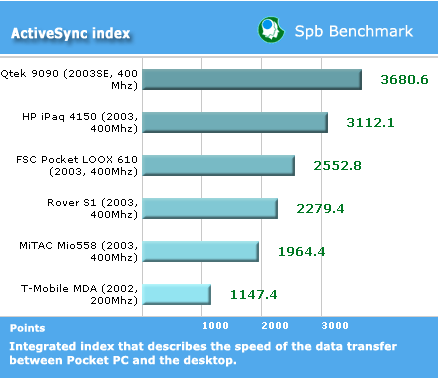
The smartphone is the leader if compare synchronization speeds.
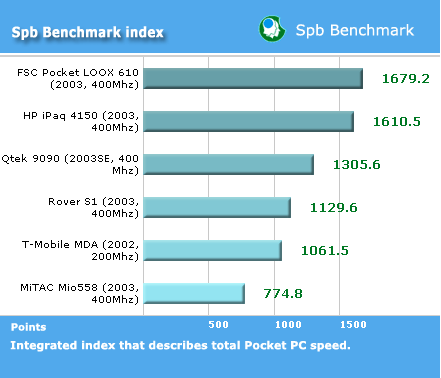
This index describes total Pocket PC speed. The result is rather
high, it is better than average. The smartphone neither shows records
nor fails. In most cases the user will not feel the difference in
the smartphone’s productivity in everyday using, but it will be
noticeable if he/she will play games or video clips.
The essential part of our reviews is the graphic test with a help
of PocketQuake without
the sound (the sound can be switched off by the console command
nosound 1, other settings are standard).

The results are not bad.
Now let us turn to tests in the video mode. We loaded several test
clips with various video-stream (kbps – kilobit per second, video
codec - DivX 5.03 was used for coding). The sound was coded in MP3
format (bit rate – 128 Kbps). The quantity of suppressed frames
was used as criteria of playback quality (the less, the better).
The initial material was the fragment from the film Cats & Dogs
(scene with fighting). The results are the following:

Functionality of wireless adapters
Before describing each adapter, let us notice the following. Bluetooth
and Wi-Fi adapters can work simultaneously, a process of switching
on/off takes few seconds. Simultaneous work is necessary, for example
if you want to use bluetooth headset during using IP-telephony.


For the first time roaming between wireless networks is realized!
Imagine the following situation (it was in reality): you connected
to the home access point, began to browse www pages, then you went
outdoors – the connection is automatically switched to GPRS after
losing Wi-Fi signal.




Bluetooth. At last HTC used standard drivers from
WIDCOMM in the smartphone, not built-in problem drivers of WM2003.
The company used not “classic” drivers from WIDCOMM (they are rather
Bluetooth for Windows CE BT-PPC/PE 1.1.0 Build 10). The new profile
for Bluetooth-headset was added in the new version of drivers. Jabra
BT250 worked without problems with Qtek 9090, it reestablished connection
after it was lost. The main problem is the shortcoming of the OS
- the absence of the voice dialing. It is possible to solve it using
special applications (for example, Voice
Command). We didn’t notice any other problems using the headset.
Other profiles were stable (connection with PC, data transferring,
business cards transferring, network connection).






Wi-Fi. Blue Angel gained a good advantage when its developers
equipped the device with Wi-Fi adapter (home access points, corporate
IP-telephony). Using a home access point, Qtek 9090 showed an average
Wi-Fi signal level, while the laptop showed the highest one. But
there were no problems with receiving Wi-Fi signal in the 3-room
flat. WPA (Wi-Fi Protected Access) support is important for corporate
smartphone usage. WPA protection is considered to be safe on the
contrast to WEP. It is possible to adjust Wi-Fi energy consumption.


GPRS. The smartphone supports both class 10 (4 receiving
channels and 1 transferring one) and class 8 (3 receiving channels
and 2 transferring ones). It is possible to switch them. The GPRS
connection was stable in the Moscow MTS network, though not very
quickly. It was interesting to carry out the following experiment:
we began downloading one HTML-page on the one metro station, there
was no connection between stations and the connection was reestablished
on each station. We needed to pass “only” 6 stations until the page
with all pictures was downloaded.

Blue Angel can be used as an external GPRS-modem for laptop or
PC. The smartphone can be connected with the PC in different ways
(Bluetooth, IrDA, COM, USB). The special application – Wmodem,
is responsible for it.
On the whole we can say that the smartphone has a good realization
of wireless adapters (both hardware and software).
Applications
The smartphone is powered by Windows Mobile 2003 SE for Pocket
PC Phone Edition. Here
you can read about its standard capabilities. WM2003, the second
edition, added a built-in function of the screen rotation, other
changes were not very important.




One more program - Telephone, was added to the standard applications
of WM2003SE. It is responsible for the “phone part” control. It
does not have any differences from other smartphones based on Pocket
PC.
Usually pre-installed extra programs have very ascetic settings.
Qtek 9090 is a pleasant exception. Several necessary and useful
applications are pre-installed in the memory of this device.


Album. This application is used to playback various
multimedia files (available resolutions are the following: bmp,
jpg, gif, avi, mp4, 3gp, mid, wav). The possibilities of the viewer
are very rich – slide show, a possibility to add comments to the
file, easy editing of the images, colors histograms viewing. .
ClearVue PDF and ClearVue PTT. Two utilities to
view documents in PDF format and MS Power Point presentations. The
formatting is saved, there are no problems with Cyrillic.


SPB GPRS Monitor. This program was developed by Russian
developers from SPB Software House. I think that it is the best
program for counting GPRS-traffic today, not only on Pocket PC.


KSE Truefax 2.0.The utility which can help to send-receive
facsimile messages. This application is sometimes indispensable
for a businessman.


MIDlet Manager. The program used to launch J2ME applets.
It was surprising that the game - YetiSports, assigned for smartphones
based on Nokia Series 60 (ÎÑ Symbian), worked properly. Usually
you can launch J2ME applications on Pocket PC resorting to various
tricks, but it is not very easy. In this case you have no problems,
everything you need is preinstalled.

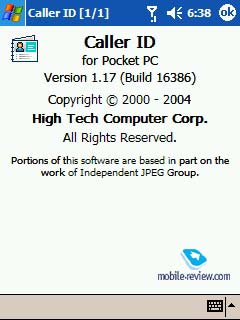
Photo Contacts. It is impossible to assign a picture to
the name in the standard address book of WM2003. Photo Contacts
help to solve this problem. The photo is displayed while incoming
call.


There are several necessary application for Sim-card in the smartphone.
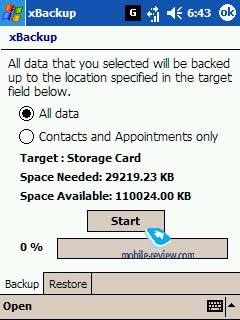
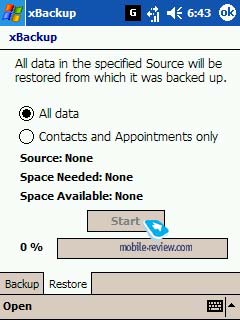
xBackup. This utility is necessary to make backup files.
It is possible to copy all data, just contacts or just calendar
events. The program has only the main functions; the capabilities
are rather ascetic. There is the utility - Permanent Save.
In reality it moves PIM data (contacts, calendar, tasks, connection
settings) from RAM to ROM. Even if the battery runs out, the data
will be saved.
That is all about applications. I can repeat one more time that
there are many extra progrmmas in this device and some of them are
very useful.
Conclusions
The connection quality is good. The sound is pure, the voice is
well heard, the volume is sufficient. The same impression was after
talking using bluetooth-headset. The vibrating alert is average,
do not rely on it, otherwise you can miss a call (for example, if
the smartphone is in the pocket of the coat). It is possible to
set several modes: ring, increasing ring, vibrate then ring, vibrate
and ring, vibrate. The volume of the speaker is enough not to miss
the call in noisy conditions or outdoors.
Compared to the second generation of Pocket PC smartphones, developers
of HTC Blue Angel added Wi-Fi adapter, increased functionality of
Bluetooth. The wireless part of the smartphone is outstanding. QWERT
keypad is well realized. The ergonomics of joystick was improved,
application key were added (the smartphone could be used for playing
arcade games). There are many extra useful applications in the device.
Qtec has rather long battery life. “Yellow” screen and average signal
of Wi-Fi are little shortcomings of thie smartphone.
Qtek9090 will be in September on the market and replace Qtek2020
in its price segment. The price of the latter one will decrease.
The same situation will be with Sony Ericsson P910 and P900 - the
latter one will not be taken out of production but decrease the
price. It is absolutely right from the marketing point of view.
The initial price will be about $1000, after that the price will
decrease to $800.
Today HTC Blue Angel is one of the most advanced smartphones. It
has more convenient keypad than Sony Ericsson P910, equipped with
Wi-Fi adapter, but has larger dimensions and weight. The main rival
of HTC Blue Angel is iPaq h6300, later Motorola MPx will appear.
The phones are similar by functions and prices. In the end of the
year we will publish a comparative article about smartphones of
the last generation.
What can we expect in the future? It is not difficult to guess
the specifications of the HTC smartphone of the next generation:
PXA270 proccessor, VGA-screen, 1 megapixel camera, 4 GSM bands,
UMTS….
Speicifications:
- Class: smartphone
- Position in the range: above HTC Himalaya
- Rivals: Motorola MPx, Sony Ericsson p910
- Operational system: Windows Mobile 2003 SE for Pocket PC Phone
Edition
- Processor: Intel XScale PXA263 400 MHz
- GSM 900/1800/1900, GPRS Class B, multislot class 10 ( switched
to class 8)
- RAM: 128 Mb (125.77 Mb available for the user)
- Available flash-memory: 43.26 Mb
- Inerfaces: SD/MMC slot with SDIO, Bluetooth, Wi-Fi, IrDA
- Display: 3.5” with the resolution of 320x240 pixels, 65 colors
- Built-in VGA camera, a possibility to record video
- Battery: removable Li-Ion of 1490 mAh capacity
- Dimensions: 125x71.6x18.7 mm (170 mm – length in the opened
mode)
- Weight: 212 g.
Anton Kotov (anton.kotov@mobile-review.com)
Translated by Maria Sennikova (maria@mobile-review.com)
Published - 18 August 2004
Have something to add?! Write us... eldar@mobile-review.com
|









